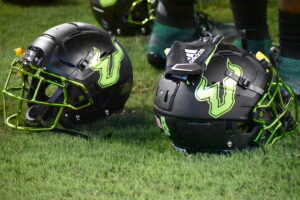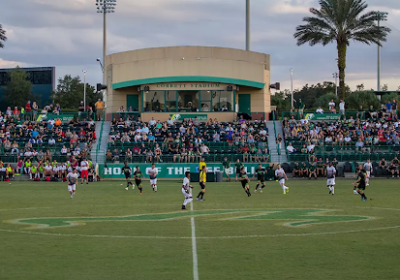Temple 17-USF 7: Postgame takeaways

There is absolutely no sugarcoating this one.
USF’s 17-7 loss to Temple on Thursday night at Raymond James Stadium was one of the most unacceptable performances in program history.
What happened to the O-line?
After playing pretty well for the past month, the Bulls’ offensive line was — well, offensive.
Redshirt freshman quarterback Jordan McCloud had to run for his life seemingly every time he dropped back to pass. Ultimately, though, he was sacked nine times.
It didn’t help that sophomore left tackle Donovan Jennings went down during the first quarter with what coach Charlie Strong called an ankle injury.
McCloud also accepted responsibility for some of the woes.
“Some of the sacks were honestly on me,” McCloud said. “I’ve got to get the ball out quicker, and we’ve just got to execute more.”
They may very well be McCloud’s fault, but without a mobile quarterback like him under center, that number is probably around 15.
Clock mismanagement
Picture this.
You’re playing Madden — or an old copy of NCAA Football — and you’re down by 10 points late in the game. The other team is driving and you have all three of your timeouts.
At some point, you’re using the timeouts, right?
Strong didn’t.
A Temple drive that started at the Owls’ 17-yard line with 9:07 remaining in the fourth quarter — which was already extended thanks to a roughing the kicker penalty after the Bulls’ defense held the Owls to a 3-and-out — wound up in a turnover on downs at the USF 9-yard line.
Strong used one timeout in the process, allowing seven minutes to tick off the clock, leaving the Bulls 2:06 to score, kick and recover an onside kick, then score again.
Both Strong and McCloud said they were saving the timeouts for when the offense passed midfield, but the timeouts should have been used on defense, honestly, because by the time USF took over, it was too little too late.
Regardless, the Bulls took two timeouts home with them, and it’s not the first time questionable clock management has happened in a game against Temple.
In last season’s 27-17 loss in Philadelphia, the Bulls took over with 49 seconds before halftime at their own 23-yard line and all three timeouts.
Rather than trying to add on to its 17-0 lead, USF ran twice and went into the break probably feeling good about itself.
The rest, as they say, is history.
The fan chants and Strong’s job security
It’s the ugly elephant in the room that has to be addressed.
Multiple times, including at the end of the game, fans were chanting things like “Fire Charlie” and “We want [Willie] Taggart.”
This feels like the game that put the final nail in the coffin in the #BullStrong era.
The game was there for the taking, but poor coaching and tons of mental mistakes — the roughing the kicker penalty that let the majority of the fourth quarter slip away, taking timeouts home with you, McCloud’s 38 passing attempts despite being a run-first offense — cost USF a win.
There’s no precedent for firing coaches midseason at USF — Jim Leavitt and Skip Holtz were fired after the season — and there’s also no precedent for football coaching changes from Vice President of Athletics Michael Kelly yet either.
So Strong may very well finish out the season as a lame-duck coach. But, regardless of whatever his mystery buyout with the USF Foundation is, it’s hard to see him being at USF in 2020.
But nobody should be happy it’s come to this. Strong is one of the nicest coaches in college football. For example, he doesn’t shame reporters for asking weird or dumb questions, like some other big-time names (Mike Gundy, for example) in the sport.
It’s just unfortunate it didn’t work out.








